May 7th Scots Book of Days
May 7 1534 to 1607 to 1641 Religious persecution laws adopted at various times in these years. The Act of Uniformity, the Test Acts and Penal Laws of England, (with jurisdiction into Ireland, Scotland and British colonies of Africa, India, and Americas), enforced by execution and torture, fine and prison, confiscation and transport to the plantations (American colonies, if ye weren’t already here) were, according to Edmund Burke “a machine of wise and elaborate contrivance, as well fitted for the oppression, impoverishment and degradation of a people, and the debasement in them of human nature itself, as ever proceeded from the perverted ingenuity of man.” Savage, John (1869). Fenian Heroes and Martyrs. Patrick Donahoe. pp. 16. Bans on Catholics, Dissenters from the Established Church, (Nonconformists, Presbyterians, Lutherans, Quakers, Covenanters, Congregationalists, Jews, Anglicans 1650-1661, Baptists, along with slaves, felons, imbeciles. and foreigners) Ban on Catholics inheriting Protestant land. Wikipedia. repealed circa 1829.
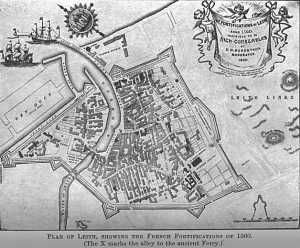 1560 Siege of Leith. Port for Edinburgh. On 7 May 1560 an unsuccessful attempt was made to storm this opening. These were continued further west, across the Water of Leith to Bonnington, where a series of batteries were established.
1560 Siege of Leith. Port for Edinburgh. On 7 May 1560 an unsuccessful attempt was made to storm this opening. These were continued further west, across the Water of Leith to Bonnington, where a series of batteries were established.
Plan of Leith, showing the French Fortifications of 1560. www.electricscotland.com/history/leith/22.htm
‘Leeth’ was strategic, because ‘Leeth’ was the port for Edinburgh, used to deliver supplies to the allied French soldiers holding the palace and capitol. Edinburgh was strategic for control of the Western passages from the south to the North. Who controlled ‘Leeth’ controlled Edinburgh, who controlled Edinburgh controlled the West, who controlled the West would eventually control Scotland, and who controlled Scotland would control the whole Island, if it took a thousand years.
The completed emplacements stretched for approximately 1 mile (1.6 km) around the fortified town, with six gun sites, at a distance of around 500 yards (460 m) from the Leith ramparts. Mounts Pelham and Somerset, named after their officers, were both large temporary forts, with ramparts up to 13 feet (4.0 m) high. Norfolk brought in expert military advisors, Sir Richard Lee and his own cousin Sir George Howard, who Norfolk believed would bring the siege to a rapid conclusion. In early May cannon made a substantial breach in the southern ramparts. Scaling ladders made for the assault were too short and there were heavy losses estimated at 1000 to 1500 Scots and English. Both Knox and a French eyewitness attributed some of the casualties to the women of Leith throwing stones from the ramparts.
Alexander Lockhart of Bar, brother of Johne, according to Helen Hill Miller. Yours for Yesterday p. 47 .
![]() Nisbet mentions only one child of the marriage [1560] between the first Andrew Millar of Temple and Killoch and Anne Stewart, their son Andrew [Millar]. Of the second Andrew’s marriage with Elizabeth Lockhart Nisbet records three children, sons named Andrew and Henry and a daughter, Mary. Knox’s Historie [of the Reformation – 1566] tells of the death of Elizabeth‘s father, Alexander Lockhart, at the siege of Leith: The greatest damage that either English or Scots received after that day, was the slaughter of two gentlemen, the one Master of Household to my Lord James, Robert Colville of Cleith, a man stout, modest, and wise; who was shot in the thigh with a falcon or hackbut of crock, and departed the misery of this life within two hours after.
Nisbet mentions only one child of the marriage [1560] between the first Andrew Millar of Temple and Killoch and Anne Stewart, their son Andrew [Millar]. Of the second Andrew’s marriage with Elizabeth Lockhart Nisbet records three children, sons named Andrew and Henry and a daughter, Mary. Knox’s Historie [of the Reformation – 1566] tells of the death of Elizabeth‘s father, Alexander Lockhart, at the siege of Leith: The greatest damage that either English or Scots received after that day, was the slaughter of two gentlemen, the one Master of Household to my Lord James, Robert Colville of Cleith, a man stout, modest, and wise; who was shot in the thigh with a falcon or hackbut of crock, and departed the misery of this life within two hours after.
- Colville of Easter Wemyss 1132 2Semple2Montgomery 2Cochrane2Miller 2Simmons2Choate zoe ToaG
The other was Alexander Lockhart, brother to the Laird of Barr, who rashly discovered himself in the trenches, was shot in the head, and immediately thereafter departed this life.
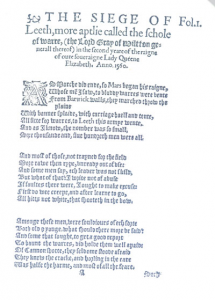 Thomas Churchyard who was present at the Siege of Leith in 1560 later wrote a poem about it called the School of War. www.leithhistory.co.uk/2007
Thomas Churchyard who was present at the Siege of Leith in 1560 later wrote a poem about it called the School of War. www.leithhistory.co.uk/2007
The slaughter continues and defeat stares in the eyes of the French, this is the turning point in British history. Not only is it the end of the Auld Alliance with France and the completion of the Reformation in Scotland. It sees the beginning of the United Kingdom. Who knew?
- Lockhart of Bar 1297 2Miller 2Simmons 2Choate 2Sorensen
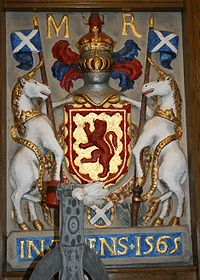 1565 Coat of arms from Leith Tollbooth inside the Church. Wikipedia.
1565 Coat of arms from Leith Tollbooth inside the Church. Wikipedia.
1603 James VI arrives in London [TG33-209].
1659 Rump Parliament restored by Richard Cromwell
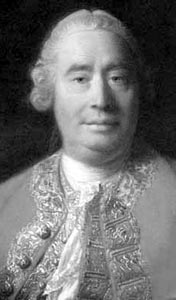 1711 David Hume, a Scottish philosopher, economist and historian. (7 May 1711 [26 April O.S.] – 25 August 1776) was a Scottish philosopher, historian, economist, and essayist, known especially for his philosophical empiricism and skepticism. He is regarded as one of the most important figures in the history of Western philosophy and the Scottish Enlightenment. Hume is often grouped with John Locke, George Berkeley, and a handful of others as a British Empiricist. Wikipedia.
1711 David Hume, a Scottish philosopher, economist and historian. (7 May 1711 [26 April O.S.] – 25 August 1776) was a Scottish philosopher, historian, economist, and essayist, known especially for his philosophical empiricism and skepticism. He is regarded as one of the most important figures in the history of Western philosophy and the Scottish Enlightenment. Hume is often grouped with John Locke, George Berkeley, and a handful of others as a British Empiricist. Wikipedia.
David Hume writings include Treatise of Human Nature (1739) and his influential Enquiry Concerning Human Understanding (1748). He explained how the mind works to acquire knowledge. Hume’s greatest popular success came in the writing of History of England from the Invasions of Julius Caesar to the Revolution of 1688 (completed in 1762).
Andrew Millar VI, London Bookseller. The British Museum possesses the correspondence between Millar and various authors and the Society for the Encouragement of Learning; he published the histories of Robertson and Hume, and Hume often took pen in hand to grumble. YYMA 64
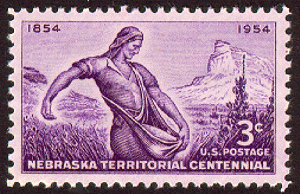 1854 Nebraska Territory centenary. “The Sower, Mitchell Pass & Scotts Bluff”
1854 Nebraska Territory centenary. “The Sower, Mitchell Pass & Scotts Bluff”
1954-05-07 Nebraska was part of the Louisiana Purchase, after which President Thomas Jefferson requested that a geographic expedition of the area be undertaken. The Lewis and Clark Expedition crossed the eastern edge of what now is Nebraska. Missionaries, traders, trappers, and travelers moved across Nebraska between 1800 and 1840. The Oregon Trail followed the Little Blue and Platte Rivers through Nebraska, and was used by thousands of wagon trains between 1830 and 1870. The Mormon Trail to Utah and The Denver Trail to Colorado also crossed Nebraska. Nebraska was part of the Indiana Territory from late 1804 until July 4, 1805, then until December 7,1812, Louisiana Territory, then Missouri Territory until 1821, when Missouri became a state. Then Nebraska was part of the unorganized region known as “Indian country” Until 1854’s Kansas -Nebraska Act. The first session of the territorial legislature met January 16, 1855. Statehood finally was achieved in 1867. Whole boatdloads of Scots traveled these trails to the west.
www.usstampgallery.com
1861 William Reading Montgomery 1825 (28) (clan Montgomery) Brigadier General. Mexican War of 1848. He served in the Civil War, attaining the position of Brigadier General of the United States Volunteers on May 7, 1861.
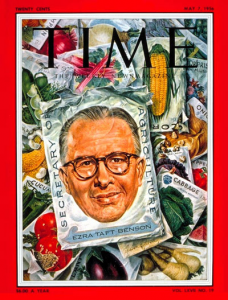 1956 Time cover featuring Secretary Agriculture Ezra Taft Benson (clans Boyd, Wilson)
1956 Time cover featuring Secretary Agriculture Ezra Taft Benson (clans Boyd, Wilson)
1998 United Health Foundation America’s Health rankings 1998 Overall. Utah ranked 1st, Oklahoma 43rd, http://www.americashealthrankings.org/OK-UT/1998.
Utah is ranked 2nd highest (4.6% of the state population) among the 50 United States with the top percentages of Scottish residents (Wikipedia 26 March 2017 https://en.wikipedia.org/wiki/Scottish_Americans#Scottish_Americans_by_state ). How are the Scots in Utah doing?
2017 Hi I’m Danielle – People. I am a Shakespeare teacher. I am missionary in the Ireland/Scotland mission. I am proud to be a Mormon.
Disclaimer: The author of each article published on this web site owns his or her own words. The opinions, beliefs and viewpoints expressed by the various authors and forum participants on this site do not necessarily reflect the opinions, beliefs and viewpoints of Utah Standard News or official policies of the USN and may actually reflect positions that USN actively opposes. ©
Utah Standard News depends on the support of readers like you.
Good Journalism requires time, expertise, passion and money. We know you appreciate the coverage here. Please help us to continue as an alternative news website by becoming a subscriber or making a donation. To learn more about our subscription options or make a donation, click here.
To Advertise on UtahStandardNews.com, please contact us at: ed@utahstandardnews.com.


Comments - No Responses to “May 7th Scots Book of Days”
Sure is empty down here...